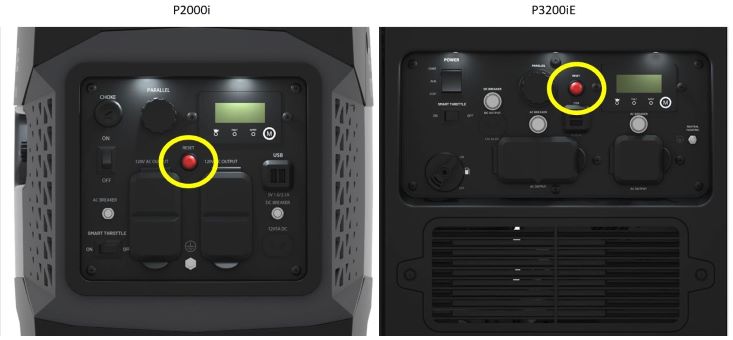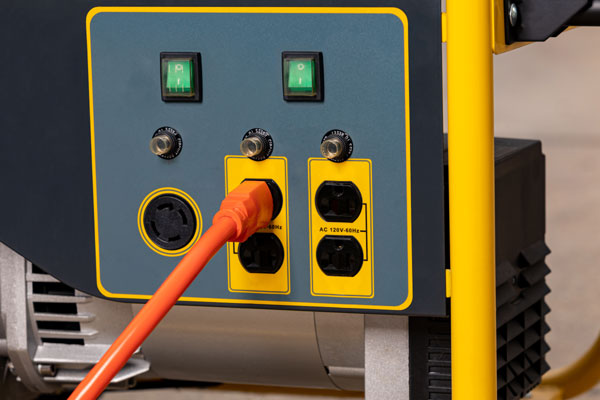To fix an overloaded generator, reduce the electrical load and reset the circuit breaker. Ensure the generator isn’t running beyond its capacity.
Generators are crucial in providing backup power during outages. Overloading can lead to equipment damage and safety hazards. Understanding how to manage and rectify an overloaded generator can prevent these issues. This guide will help you maintain your generator’s performance and safety.
Learn the steps to identify overload signs and implement effective solutions. Regular maintenance and proper load management are essential. By following these tips, you can ensure your generator operates efficiently and safely during power outages. Protect your investment and ensure a reliable power supply by addressing generator overloads promptly.

Credit: www.youtube.com
Identifying Overload Symptoms
Understanding overload symptoms is crucial for maintaining your generator. An overloaded generator can lead to severe damage. Knowing the signs helps in taking timely action.
Common Signs
Several signs indicate that your generator is overloaded. Look for these common symptoms:
- Frequent tripping of the circuit breaker
- Dim or flickering lights
- Unusual noises or vibrations
- Excessive heat from the generator
- Reduced power output
These signs are easy to spot. Early detection can save your generator from further damage.
Impact On Performance
An overloaded generator affects its performance. The most noticeable impacts include:
| Impact | Description |
|---|---|
| Reduced Efficiency | The generator works harder, consuming more fuel. |
| Component Damage | Overheating can damage internal parts. |
| Inconsistent Power | The generator may provide unstable power supply. |
| Potential Shutdown | Severe overload can cause the generator to shut down. |
Understanding these impacts helps in maintaining your generator’s longevity. Regular checks and timely action are essential.
Understanding Generator Capacity
Fixing an overloaded generator starts with understanding its capacity. Knowing the limits of your generator is crucial. This ensures you use it efficiently and safely. Let’s explore how to understand generator capacity.
Power Ratings
Generators have specific power ratings. These ratings tell you the maximum power they can handle. Look for two main ratings: running watts and starting watts.
- Running Watts: The continuous power your generator can provide.
- Starting Watts: The extra power needed for starting appliances.
Check these ratings on your generator’s manual or label. Knowing these numbers helps prevent overloads.
Load Calculations
Calculate the total load your generator can handle. Add up the wattage of all devices you want to power. Use the following table for a simple calculation:
| Device | Running Watts | Starting Watts |
|---|---|---|
| Refrigerator | 700 | 1200 |
| Television | 200 | 200 |
| Air Conditioner | 1000 | 1500 |
Add all the running watts. Ensure the total is less than your generator’s running watts. For starting watts, add the highest starting wattage to the total running watts. This ensures your generator can handle peak demands.
By understanding these aspects, you can avoid overloading your generator. This keeps your generator running smoothly and prolongs its life.
Immediate Actions To Take
Dealing with an overloaded generator can be tricky. Immediate actions are crucial to prevent further damage. Follow these steps to ensure safety and inspect for issues.
Shutting Down Safely
First, turn off all connected appliances. This reduces the load on the generator.
- Turn off the generator’s main switch.
- Allow the generator to cool down for 15 minutes.
- Disconnect the generator from the power source.
Important: Never touch a hot generator. Always wait for it to cool down.
Inspecting For Damage
After shutting down, inspect the generator for visible damage.
- Check for burnt wires or connections.
- Look for oil leaks around the engine.
- Ensure the fuel tank is intact and not leaking.
Use a flashlight to inspect hard-to-see areas. If you find any damage, consult a professional.
| Component | Signs of Damage |
|---|---|
| Wires | Burnt or frayed |
| Engine | Oil leaks |
| Fuel Tank | Leaks or cracks |

Credit: www.polarispower.com
Preventive Maintenance
Preventive maintenance is crucial for keeping your generator in top shape. It helps avoid overload and other issues. Regular checks ensure the generator runs smoothly. Scheduled servicing catches problems early. This approach saves time and money.
Regular Inspections
Regular inspections help spot small issues before they grow. Check the generator for any signs of wear and tear. Look for frayed wires, loose parts, or oil leaks. Inspect the fuel system and air filters. Use a checklist to ensure nothing is missed.
| Component | Inspection Frequency |
|---|---|
| Oil Levels | Weekly |
| Air Filters | Monthly |
| Fuel System | Quarterly |
Scheduled Servicing
Scheduled servicing includes professional check-ups. Technicians perform detailed inspections and repairs. They replace old parts and update software. This keeps the generator running efficiently. Follow the manufacturer’s guidelines for service intervals.
- Book a service appointment with a certified technician.
- Ensure all parts are inspected and tested.
- Replace worn-out components promptly.
Scheduled servicing reduces the risk of overload. It extends the lifespan of your generator. Always keep a record of maintenance activities. This helps track the health of the generator.
Balancing The Load
Balancing the load on your generator is essential. This ensures it runs efficiently and prevents overloading. An overloaded generator can cause damage to your devices and the generator itself. Understanding how to balance the load can extend the life of your generator and improve its performance.
Prioritizing Devices
Prioritizing devices helps manage the load on your generator. Start by identifying essential devices.
- Refrigerator
- Lights
- Medical equipment
These devices should be powered first. Non-essential devices can wait until the load is balanced. Use a table to manage device priorities:
| Device | Priority | Power (Watts) |
|---|---|---|
| Refrigerator | High | 600 |
| Lights | High | 100 |
| TV | Low | 150 |
Calculate the total wattage of high-priority devices. Ensure it does not exceed the generator’s capacity.
Using Load Management Systems
Load management systems help distribute power efficiently. These systems automatically balance the load.
- Install a load management system.
- Connect it to your generator.
- Program the system to prioritize devices.
Some systems even allow remote control via apps. This provides convenience and ensures optimal load distribution.
Smart devices can also be integrated. They monitor and adjust the load in real-time.
Using these strategies, you can effectively manage and balance the load on your generator.
Upgrading Your Generator
An overloaded generator can cause significant disruptions. Upgrading your generator ensures it meets your power needs. This section will guide you through the process.
When To Upgrade
Is your generator frequently tripping? This could signal an upgrade is needed.
Does your generator struggle to power all your devices? This is another sign.
If your generator is old, an upgrade might boost efficiency. Consider upgrading if repairs are frequent and costly.
Choosing The Right Model
Selecting the right generator model is crucial. Here are some tips.
- Assess Your Power Needs: Calculate the wattage your devices require.
- Consider Fuel Type: Choose between gasoline, diesel, or propane generators.
- Check Portability: Decide if you need a portable or stationary generator.
Use this table to compare key features of generator models:
| Feature | Model A | Model B |
|---|---|---|
| Wattage | 2000W | 3000W |
| Fuel Type | Gasoline | Diesel |
| Portability | Portable | Stationary |
Reading reviews can provide insights from other users. Consulting a professional can also help you make an informed decision.
Using Backup Solutions
Generators can sometimes become overloaded, causing significant issues. Using backup solutions can help manage this problem effectively. This section will explore two key backup solutions: Portable Generators and Battery Systems.
Portable Generators
Portable generators are a great backup solution. They provide power when the main generator fails. These generators are easy to move and use. You can set them up quickly in case of an emergency. Portable generators also come in various sizes. Choose one based on your power needs.
Here are some benefits of portable generators:
- Easy to transport
- Quick setup
- Versatile power options
- Cost-effective
Make sure to perform regular maintenance. This keeps the portable generator in good condition. Check oil levels and clean filters often. Always have extra fuel stored safely.
Battery Systems
Battery systems are another excellent backup solution. They store power for later use. These systems are quiet and easy to install. Battery systems can be a reliable source of backup power.
Consider these advantages of battery systems:
- Quiet operation
- Easy installation
- Low maintenance
- Environmentally friendly
Battery systems can support your power needs during outages. They are also great for reducing your energy costs. Use them along with solar panels for more benefits.
Here is a quick comparison of portable generators and battery systems:
| Feature | Portable Generators | Battery Systems |
|---|---|---|
| Noise Level | Loud | Quiet |
| Installation | Quick setup | Easy installation |
| Maintenance | Regular maintenance needed | Low maintenance |
| Environmental Impact | Uses fuel | Eco-friendly |
Using backup solutions like portable generators and battery systems can help manage an overloaded generator effectively.

Credit: www.batteryequivalents.com
Hiring Professional Help
Dealing with an overloaded generator can be tricky. Sometimes, hiring professional help is the best solution. Professionals can diagnose and fix issues quickly. They ensure your generator runs smoothly and safely.
When To Call An Expert
Knowing when to call an expert is crucial. Here are some signs:
- Your generator frequently shuts down.
- You notice strange noises or smells.
- The generator shows error codes.
- There are visible sparks or smoke.
- The unit fails to start or runs inconsistently.
These signs indicate serious issues. A professional can address these problems effectively.
What To Expect From Service
Hiring a professional involves several steps. Here’s what you can expect:
| Step | Description |
|---|---|
| 1. Initial Inspection | The technician examines the generator for obvious issues. |
| 2. Diagnostic Tests | They run tests to identify the root cause of the problem. |
| 3. Detailed Report | You receive a report outlining the issues and solutions. |
| 4. Repair and Maintenance | The technician performs necessary repairs and maintenance. |
| 5. Final Testing | They conduct final tests to ensure the generator works properly. |
Professional service ensures your generator is safe and efficient. It also extends the lifespan of your equipment.
Frequently Asked Questions
What Causes A Generator To Overload?
A generator overload happens when it supplies more power than its capacity.
How To Identify Generator Overload?
You can identify overload by checking for overheating, strange noises, or flickering lights.
Can An Overloaded Generator Be Fixed?
Yes, by reducing the load, resetting the generator, and checking for any faults.
What Steps To Reset An Overloaded Generator?
Turn off the generator, reduce the load, and restart it after a few minutes.
How To Prevent Generator Overloading?
Regularly check the load, use power management, and ensure proper maintenance of the generator.
What Are The Risks Of Generator Overload?
Overloading can cause overheating, damage to equipment, and potential fire hazards.
Conclusion
Fixing an overloaded generator is crucial for safety and efficiency. Follow the steps outlined to prevent future overloads. Regular maintenance and proper usage ensure longevity. Always monitor your generator’s load capacity. This helps avoid costly repairs and downtime. Keep these tips in mind to maintain a reliable and efficient generator.
